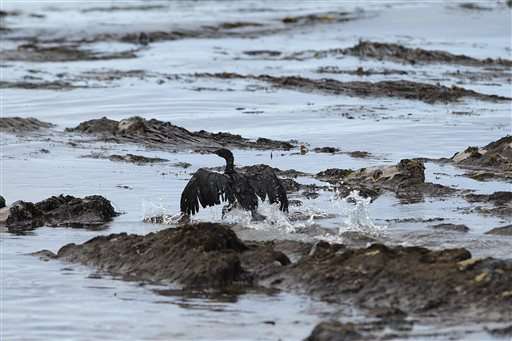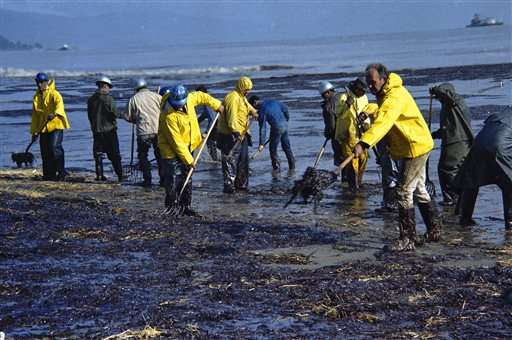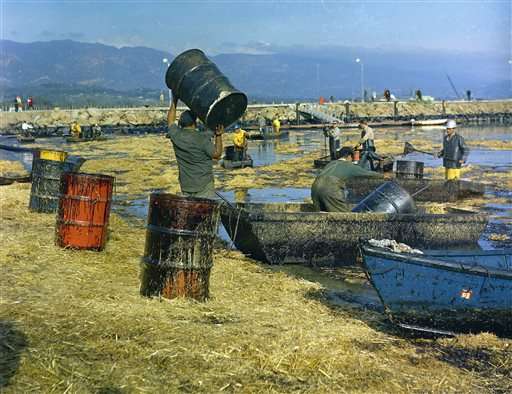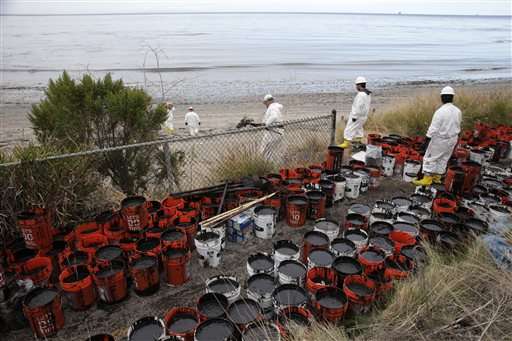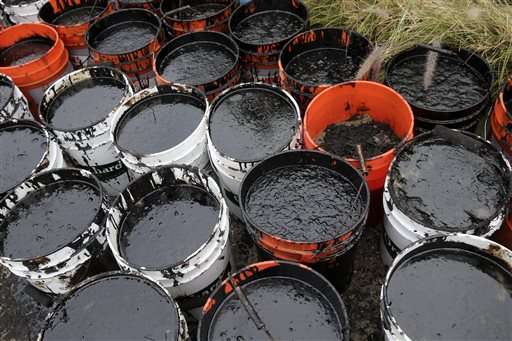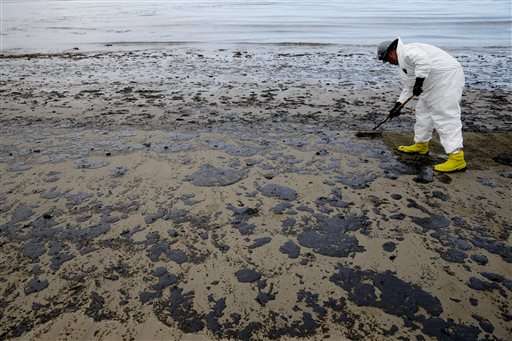A bird covered in oil flaps its wings at Refugio State Beach, north of Goleta, Calif., Thursday, May 21, 2015. More than 7,700 gallons of oil has been raked, skimmed and vacuumed from a spill that stretched across 9 miles of California coast, just a fraction of the sticky, stinking goo that escaped from a broken pipeline, officials said. (AP Photo/Jae C. Hong)
An oil slick stretched across 9 miles of coastal waters Thursday after a pipeline rupture spilled thousands of gallons of sticky, stinking crude just north of Santa Barbara. Crews are working around the clock to rake, skim and vacuum it up.
The coastline was the scene of a much larger spill in 1969—the largest in U.S. waters at the time. Here are some things to know about the two spills:
___
VOLUME OF CRUDE
The 1969 blowout at a Union Oil Co. offshore platform dumped more than 3 million gallons of crude oil over a span of a month. Up to 30 miles of beaches were fouled.
Tuesday's pipeline break lasted about three hours. According to initial estimates, it spilled up to 105,000 gallons, with the majority of the oil remaining on land.
Up to 21,000 gallons reached the sea, early estimates show.
___
BIRDS, SEA LIFE
The 1969 spill killed 9,000 birds, 8.8 million barnacles, 30,000 mussels and 51,800 limpets, according to tallies by biology professor Michael Neushul of the University of California, Santa Barbara.
He and his students were unable to prove significant numbers of deaths among fish, whales, elephant seals, sea lions or plankton.
Tuesday's spill was mostly contained near one section of coastline at Refugio Beach. So far, there is no evidence of widespread harm to birds and sea life.
Other environmental impacts are still being assessed.
___
CALL TO ARMS
The 1969 disaster is credited with giving rise to the American environmental movement.
In this Feb. 6, 1969, file photo, state forestry conservation crews gather up oil-soaked straw on a beach in Santa Barbara, Calif. Cleanup crews fanned out once again on Wednesday, May 20, 2015, after thousands of gallons of crude oil spilled from a broken pipe and flowed into the Pacific Ocean along the same stretch of coastline as the 1969 spill, which was the largest ever in U.S. waters at the time and is credited with giving rise to the American environmental movement. (AP Photo/Wally Fong)
Groups like the Environmental Defense Center and Get Oil Out! formed in its aftermath.
That spill led to a prohibition on new offshore platforms in federal waters off California. But companies have used fracking and other techniques in an attempt to stimulate new production from old wells.
___
OFFSHORE RIGS
In this Feb. 7, 1969 file photo, workers collect oil-soaked straw from the beach at Santa Barbara Harbor, Calif., following a leak from an off-shore well that covered area beaches. Cleanup crews fanned out again on Wednesday, May 20, 2015, after thousands of gallons of crude oil spilled from a broken pipe and flowed into the Pacific Ocean along the same stretch of coastline as the 1969 spill, which was the largest ever in U.S. waters at the time. (AP Photo,)
California has not issued a new lease for offshore oil drilling since 1968.
However, large offshore rigs still dot the horizon off the coast, pumping crude to shore. Small amounts of tar from natural seepage regularly show up on beaches.
Environmental groups used Tuesday's spill as a new opportunity to take a shot at fossil fuels and remind people of the area's notoriety with oil spills.
-
Plastic buckets with oil collected from the beach are placed at the side at Refugio State Beach, north of Goleta, Calif., Thursday, May 21, 2015. More than 7,700 gallons of oil has been raked, skimmed and vacuumed from a spill that stretched across 9 miles of California coast, just a fraction of the sticky, stinking goo that escaped from a broken pipeline, officials said. (AP Photo/Jae C. Hong)
-
Plastic buckets filled with oil collected from the beach at Refugio State Beach, north of Goleta, Calif., Thursday, May 21, 2015. More than 7,700 gallons of oil has been raked, skimmed and vacuumed from a spill that stretched across 9 miles of California coast, just a fraction of the sticky, stinking goo that escaped from a broken pipeline, officials said. (AP Photo/Jae C. Hong)
-
A worker removes oil from the beach at Refugio State Beach, north of Goleta, Calif., Thursday, May 21, 2015. More than 7,700 gallons of oil has been raked, skimmed and vacuumed from a spill that stretched across 9 miles of California coast, just a fraction of the sticky, stinking goo that escaped from a broken pipeline, officials said. (AP Photo/Jae C. Hong)
© 2015 The Associated Press. All rights reserved.
